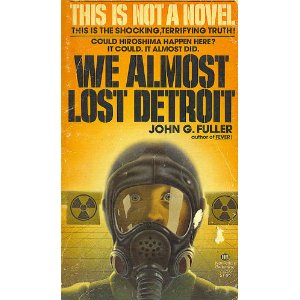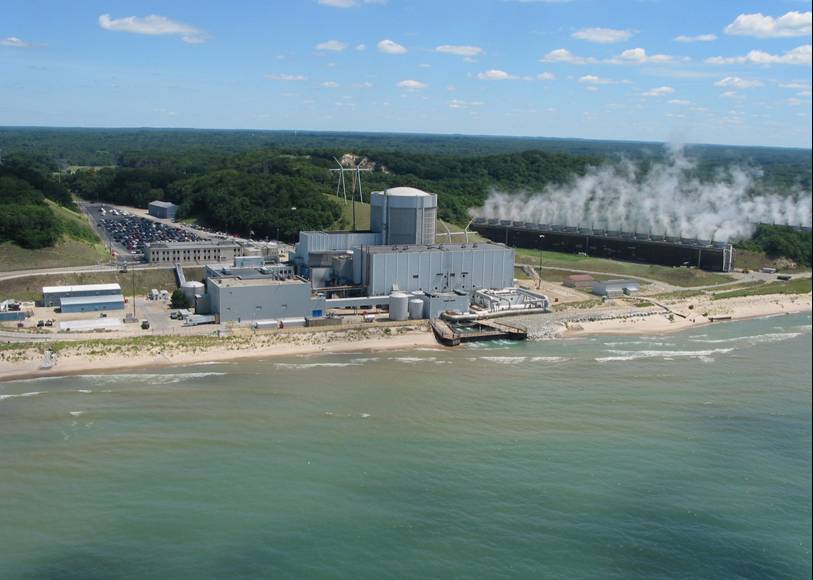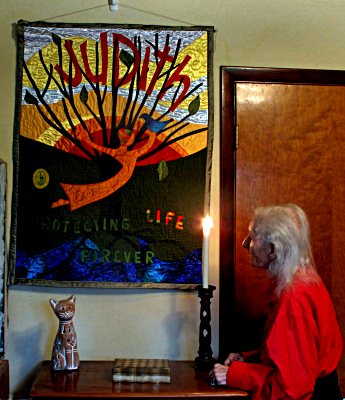 A cover on the 1975 non-fiction book by John G. Fuller, "We Almost Lost Detroit," about the 1966 meltdown at the Fermi 1 experimental plutonium breeder reactor in Monroe, MichiganBeyond Nuclear and its allies in the intervention against the proposed new Fermi 3 atomic reactor in Monroe, Michigan have filed their 25th contention opposing the proposed new atomic reactor, citing a violation of the National Historic Preservation Act (NHPA). NRC, Detroit Edison and the State of Michigan have finalized a NHPA mitigation Memorandum of Agreement about the demolition of the Fermi 1 containment shell, despite its inclusion on the National Register of Historic Places, in order to make room for the construction of Fermi 3, a General Electric-Hitachi so-called "Economic Simplified Boiling Water Reactor" (ESBWR) . However, the decisions were made without even notifying -- let alone involving -- the public, a violation of NHPA. The coalition has issued a media release.
A cover on the 1975 non-fiction book by John G. Fuller, "We Almost Lost Detroit," about the 1966 meltdown at the Fermi 1 experimental plutonium breeder reactor in Monroe, MichiganBeyond Nuclear and its allies in the intervention against the proposed new Fermi 3 atomic reactor in Monroe, Michigan have filed their 25th contention opposing the proposed new atomic reactor, citing a violation of the National Historic Preservation Act (NHPA). NRC, Detroit Edison and the State of Michigan have finalized a NHPA mitigation Memorandum of Agreement about the demolition of the Fermi 1 containment shell, despite its inclusion on the National Register of Historic Places, in order to make room for the construction of Fermi 3, a General Electric-Hitachi so-called "Economic Simplified Boiling Water Reactor" (ESBWR) . However, the decisions were made without even notifying -- let alone involving -- the public, a violation of NHPA. The coalition has issued a media release.
The intervenors have cited Atomic Energy Commission,Nuclear Power Development Corporation (Dow Chemical, Detroit Edison, et al.), U.S. congressional testimony, anddocumentation on how close the Fermi 1 meltdown of October 5, 1966 came to a "terrifying," catastrophic radioactivity release. The coalition's attorney, Terry Lodge of Toledo, has argued that the Fermi 1 archive must include documentation of the experimental plutonium breeder reactor's original goal of generating weapons-grade plutonium for U.S. hydrogen bombs, as well as materials for radiological ("dirty bomb") weaponry. "The 'official' narrative of this 20th century failure must not be hijacked for use as pro-industry promotion by the 21st century nuclear industry," Lodge said.
"The story of Fermi 1's nearly catastrophic failure offers a large window into the history of commercial nuclear power, an institutional void of safety culture within the primary regulatory agency, and nuclear power’s inherent weapons connection," said Keith Gunter of Livonia, Michigan, a launch partner of Beyond Nuclear and an official intervenor against Fermi 3. "After all, as John G. Fuller's book and Gil Scott-Heron's song titles put it, 'We Almost Lost Detroit,' not to mention Monroe, Toledo, and beyond," Keith Gunter added. (see image, above left)
 NRC file photo of Palisades atomic reactor
NRC file photo of Palisades atomic reactor




 October 17, 2012
October 17, 2012
